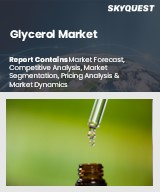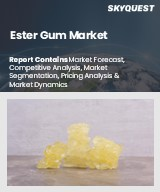
|
시장보고서
상품코드
1628064
세계의 트리아세틴 시장 : 기회, 성장 촉진요인, 산업 동향 분석 및 예측(2025-2034년)Triacetin Market Opportunity, Growth Drivers, Industry Trend Analysis, and Forecast 2025 to 2034 |
||||||
세계의 트리아세틴 시장은 2024년 3억 6,310만 달러, 2025년부터 2034년까지 연평균 복합 성장률(CAGR) 5.1%로 성장할 것으로 예측됩니다.
이러한 성장은 주로 폴리머의 가소제로서의 이용이 증가하고, 다양한 산업적 용도에서의 유연성 향상에 기여하기 때문입니다. 코팅제, 잉크 및 기타 제형에서의 역할은 수요 증가를 더욱 두드러지게 합니다.
트리아세틴의 다양한 용도도 여러 산업에서의 용도를 지원합니다. 담배 제품의 보습제로 사용하는 것은 성장을 뒷받침하는 중요한 요소 중 하나입니다. 게다가, 의약품 및 화장품에 대한 배합은 그 적응성과 다양한 분야에서의 관련성을 돋보이게 합니다. 이러한 광범위한 기능성으로 인해 여러 시장에서 선호되는 옵션이되었습니다.
지속가능한 솔루션에 대한 관심 증가는 트리아세틴이 중요한 가소제 역할을 하는 생분해성 플라스틱에 대한 수요를 강화하고 있습니다. 산업계가 환경 친화적인 재료를 선호하는 동안, 트리아세틴은 생분해성 제품의 유연성과 내구성을 높이는 점에서 점점 인식되고 있습니다. 이러한 변화는 환경적으로 지속 가능한 관행을 채택하려는 세계적인 노력과 일치합니다.
| 시장 범위 | |
|---|---|
| 시작연도 | 2024년 |
| 예측연도 | 2025-2034년 |
| 시작금액 | 3억 6,310만 달러 |
| 예측 금액 | 8억 2,280만 달러 |
| CAGR | 5.1% |
식음료 산업도 시장 확대에 큰 영향을 미칩니다. 트리아세틴은 유화제 및 안정제로 널리 사용되며 가공 식품 및 포장 식품의 일관성과 품질을 보장합니다. 빨리 먹을 수 있고 매일 먹는 음식에 대한 소비자의 선호도가 높아지면서 이 분야 수요를 계속 견인하고 있습니다.
시장은 식품 등급 응용 분야에서 현저한 성장을 이루고 있으며, 이 분야는 2034년까지 연평균 복합 성장률(CAGR) 10.8%로 4억 1,040만 달러에 이를 것으로 예측됩니다. 식품 첨가물, 용제, 보습제로서의 트리아세틴의 다용도성에 의해 제품의 식감, 보존 기간, 전체적인 품질을 향상시키는 귀중한 원료가 되고 있습니다.
2024년에는 용제 용도 분야가 43.5% 시장 점유율을 차지하고 1억 5,780만 달러가 되었으며, 2034년까지 9.3%의 연평균 복합 성장률(CAGR)로 성장할 것으로 예상되고 있습니다. 환경 친화적이고 생분해성이 높기 때문에 의약품 및 화장품의 배합에 매우 적합하며 지속 가능한 성분에 대한 규제와 소비자의 요구 증가에 부응하고 있습니다.
2034년까지 1억 7,930만 달러에 이를 것으로 예상되는 미국 시장은 의약품, 식품, 화장품 및 산업용도에서 강력한 성장을 이루고 있습니다. 바이오 화학물질에 대한 규제 당국의 지원이 기술 혁신을 촉진하는 한편, 클린 라벨로 지속 가능한 제품을 요구하는 소비자 수요가 계속 시장 동향을 형성하고 있습니다.
목차
제1장 조사 방법과 조사 범위
제2장 주요 요약
제3장 업계 인사이트
- 생태계 분석
- 밸류체인에 영향을 주는 요인
- 이익률 분석
- 파괴
- 미래 전망
- 제조업체
- 유통업체
- 공급자의 상황
- 이익률 분석
- 주요 뉴스
- 규제 상황
- 영향요인
- 업계에 미치는 영향요인
- 성장 촉진요인
- 생분해성 플라스틱 수요 증가
- 담배 산업의 성장
- 식음료 분야의 확대
- 시장의 과제
- 규제 우려와 원료 가격 변동
- 성장 촉진요인
- 규제와 시장에 미치는 영향
- Porter's Five Forces 분석
- PESTEL 분석
제4장 경쟁 구도
- 소개
- 기업 점유율 분석
- 경쟁 포지셔닝 매트릭스
- 전략 전망 매트릭스
제5장 시장 규모와 예측 : 그레이드별, 2021-2034년
- 주요 동향
- 의약품 등급
- 식품 등급
- 공업용 등급
제6장 시장 규모와 예측 : 유형별, 2021-2034년
- 주요 동향
- 가소제
- 용제
- 보습제
제7장 시장 규모와 예측 : 최종 용도별, 2021-2034년
- 주요 동향
- 플라스틱 및 폴리머
- 음식
- 의약품 및 헬스케어
- 화장품 및 퍼스널케어
- 담배
제8장 시장 규모와 예측 : 지역별, 2021-2034년
- 주요 동향
- 북미
- 미국
- 캐나다
- 유럽
- 영국
- 독일
- 프랑스
- 이탈리아
- 스페인
- 러시아
- 아시아태평양
- 중국
- 인도
- 일본
- 한국
- 호주
- 라틴아메리카
- 브라질
- 멕시코
- 중동 및 아프리카
- 남아프리카
- 사우디아라비아
- 아랍에미리트(UAE)
제9장 기업 프로파일
- Celanese Corporation
- ChemCeed LLC
- China Skyrun Industrial Co., Ltd.
- Daicel Corporation
- Eastman Chemical Company
- Haihang Industry Co., Ltd.
- Henan GP Chemicals Co., Ltd.
- Henan Huayin Chemical Co., Ltd.
- Jiangsu Lemon Chemical & Technology Co., Ltd.
- Jiangxi Acetron Chemical Co., Ltd.
The Global Triacetin Market, valued at USD 363.1 million in 2024, is expected to grow at a CAGR of 5.1% between 2025 and 2034. This growth is primarily driven by its increasing utilization as a plasticizer in polymers, contributing to enhanced flexibility across various industrial applications. Its role in coatings, inks, and other formulations further underscores its expanding demand.
Triacetin's versatility also supports its applications in several industries. Its use as a humectant in tobacco products is one of the key factors fueling its growth. In addition, its incorporation in pharmaceuticals and cosmetics highlights its adaptability and relevance across diverse sectors. This broad functionality makes it a preferred choice in several markets.
The growing focus on sustainable solutions has bolstered the demand for biodegradable plastics, where triacetin serves as a critical plasticizer. As industries prioritize eco-friendly materials, triacetin is increasingly recognized for enhancing the flexibility and durability of biodegradable products. This shift aligns with global efforts to adopt environmentally sustainable practices.
| Market Scope | |
|---|---|
| Start Year | 2024 |
| Forecast Year | 2025-2034 |
| Start Value | $363.1 Million |
| Forecast Value | $822.8 Million |
| CAGR | 5.1% |
The food and beverage industry also significantly influences market expansion. Triacetin is widely used as an emulsifier and stabilizer, ensuring consistency and quality in processed and packaged food. The rising consumer preference for ready-to-eat and long-lasting food products continues to drive its demand in this sector.
The market is witnessing significant growth in food-grade applications, with this segment projected to reach USD 410.4 million by 2034 at a CAGR of 10.8%. Triacetin's versatility as a food additive, solvent, and humectant makes it a valuable ingredient for improving product texture, shelf life, and overall quality.
In 2024, the solvent application segment accounted for a market share of 43.5%, valued at USD 157.8 million, and is expected to grow at a 9.3% CAGR through 2034. Its eco-friendly and biodegradable properties make it highly desirable for pharmaceutical and cosmetic formulations, meeting increasing regulatory and consumer demands for sustainable ingredients.
The U.S. market, projected to reach USD 179.3 million by 2034, is seeing robust growth across pharmaceuticals, food, cosmetics, and industrial applications. Regulatory support for bio-based chemicals is fostering innovation, while consumer demand for clean-label and sustainable products continues to shape market trends.
Table of Contents
Chapter 1 Methodology & Scope
- 1.1 Market scope & definition
- 1.2 Base estimates & calculations
- 1.3 Forecast calculation
- 1.4 Data sources
- 1.4.1 Primary
- 1.4.2 Secondary
- 1.4.2.1 Paid sources
- 1.4.2.2 Public sources
Chapter 2 Executive Summary
- 2.1 Industry synopsis, 2021-2034
Chapter 3 Industry Insights
- 3.1 Industry ecosystem analysis
- 3.1.1 Factor affecting the value chain
- 3.1.2 Profit margin analysis
- 3.1.3 Disruptions
- 3.1.4 Future outlook
- 3.1.5 Manufacturers
- 3.1.6 Distributors
- 3.2 Supplier landscape
- 3.3 Profit margin analysis
- 3.4 Key news & initiatives
- 3.5 Regulatory landscape
- 3.6 Impact forces
- 3.7 Industry impact forces
- 3.7.1 Growth drivers
- 3.7.1.1 Increased demand for biodegradable plastics
- 3.7.1.2 Growth in the tobacco industry
- 3.7.1.3 Expansion of the food and beverage sector
- 3.7.2 Market challenges
- 3.7.2.1 Regulatory concerns and price volatility of raw materials
- 3.7.1 Growth drivers
- 3.8 Regulations & market impact
- 3.9 Porter's analysis
- 3.10 PESTEL analysis
Chapter 4 Competitive Landscape, 2024
- 4.1 Introduction
- 4.2 Company market share analysis
- 4.3 Competitive positioning matrix
- 4.4 Strategic outlook matrix
Chapter 5 Market Size and Forecast, By Grade, 2021-2034 (USD Million) (Kilo Tons)
- 5.1 Key trends
- 5.2 Pharmaceutical grade
- 5.3 Food grade
- 5.4 Industrial grade
Chapter 6 Market Size and Forecast, By Type, 2021-2034 (USD Million) (Kilo Tons)
- 6.1 Key trends
- 6.2 Plasticizer
- 6.3 Solvent
- 6.4 Humectant
Chapter 7 Market Size and Forecast, By End Use, 2021-2034 (USD Million) (Kilo Tons)
- 7.1 Key trends
- 7.2 Plastics and polymers
- 7.3 Food and beverage
- 7.4 Pharmaceuticals and healthcare
- 7.5 Cosmetics and personal care
- 7.6 Tobacco
Chapter 8 Market Size and Forecast, By Region, 2021-2034 (USD Million) (Kilo Tons)
- 8.1 Key trends
- 8.2 North America
- 8.2.1 U.S.
- 8.2.2 Canada
- 8.3 Europe
- 8.3.1 UK
- 8.3.2 Germany
- 8.3.3 France
- 8.3.4 Italy
- 8.3.5 Spain
- 8.3.6 Russia
- 8.4 Asia Pacific
- 8.4.1 China
- 8.4.2 India
- 8.4.3 Japan
- 8.4.4 South Korea
- 8.4.5 Australia
- 8.5 Latin America
- 8.5.1 Brazil
- 8.5.2 Mexico
- 8.6 MEA
- 8.6.1 South Africa
- 8.6.2 Saudi Arabia
- 8.6.3 UAE
Chapter 9 Company Profiles
- 9.1 Celanese Corporation
- 9.2 ChemCeed LLC
- 9.3 China Skyrun Industrial Co., Ltd.
- 9.4 Daicel Corporation
- 9.5 Eastman Chemical Company
- 9.6 Haihang Industry Co., Ltd.
- 9.7 Henan GP Chemicals Co., Ltd.
- 9.8 Henan Huayin Chemical Co., Ltd.
- 9.9 Jiangsu Lemon Chemical & Technology Co., Ltd.
- 9.10 Jiangxi Acetron Chemical Co., Ltd.



















